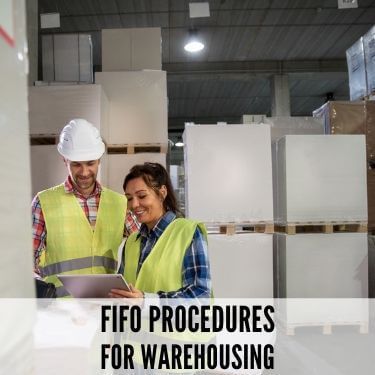
 Copy URL to Clipboard
Copy URL to Clipboard
If there’s one thing that’s true in warehousing, it’s that you need a strategy. You’ll find a number of different solutions available to you. The FIFO procedure is one way you can manage your warehouse. Learn more about this method and how to implement FIFO in your warehouse.
Leverage the best warehouse strategy to meet your business needs. FIFO stands for First In, First Out. It is a procedure which means the oldest inventory is shipped out first. FIFO, FEFO and LIFO all apply in different situations. Integrate FIFO procedures into your warehouse to strategize and streamline operations.
Table of Contents

FIFO stands for First In, First Out. It is as simple as it sounds. When using this method of warehouse management, the oldest stock of inventory is shipped out first. The newest inventory stays until the oldest is shipped out to stores or directly to consumers.
The FIFO procedure for distribution is a solid strategy to choose if the products in your warehouse have a shelf life. Items like batteries, beauty products, fashion and apparel, nutraceuticals and supplements all need to move quickly. If you're warehousing products with an expiration date, FIFO warehousing procedures might be for you. When using a FIFO method, the oldest inventory moves first.
In the most simple terms, FIFO warehousing compares to the method you might use to keep your refrigerator at home organized. When you’re running low on milk, you likely buy a new gallon and place it behind the almost empty gallon. You wait until the old milk is gone before moving the new milk to the front and using it on your cereal or pouring it in your coffee.
FIFO can be a cost-effective method to manage warehouse inventory. FIFO allows retailers and ecommerce businesses to get products to stores and customers quickly.
The FIFO method assumes easy cost flow.
GET A QUOTE
A FIFO warehouse is often compared to FEFO and LIFO methods of warehousing. Learn more about these procedures and how they compare to FIFO.
FEFO stands for First Expiring, First Out. Like FIFO, it is as simple as it sounds. When using this method of warehouse management, the stock that expires first is shipped out first. The inventory that expires first is sent out to stores or directly to consumers first. FEFO might be the strategy for you if your products expire quickly. Many certified food grade warehouses rely on FEFO procedures to keep inventory fresh.
Again, you might compare the FEFO method to a method you use to organize your refrigerator at home. You might keep products with a brief shelf life (like fresh meat from the butcher) or dairy products in front of more shelf-stable products so they are used first.
Fast-moving consumer goods are good candidates for FEFO warehousing methods. Warehouses storing pharmaceutical products and medicines might take advantage of a FEFO procedure to quickly distribute inventory purchased.
LIFO stands for Last In, First Out. In this case, the products that are moved into the warehouse most recently are shipped out first. This means the new stock takes precedence over the old stock.
If your warehouse products that don’t expire, LIFO might be for you. Your accountant might like it if you use LIFO, too. You might find that using LIFO allows you to relate recent costs to recent revenue. This can be a worthwhile approach if your costs of manufacturing the product are on the rise. If the products being sold are made less expensively, this can alter your profit margins by providing you with old information opposed to what’s happening right now.
LIFO is only an option for products that don’t expire. Bricks, sand and coal might all be warehoused with LIFO procedures. These products don’t expire and in many cases, the new batch is placed on top of the old batch in the warehouse.
GET A QUOTE
In many cases, the warehousing procedure you choose depends on the product you are warehousing. With products that have a lifespan, FIFO might be the best option. Products move quickly through the warehouse and inventory costs are reduced. FEFO is also a solid method for expiring products. LIFO only applies to stable goods that don’t apply to any timeline. Selecting a method for warehousing depends on the products you’ll be storing.

Logistics and warehousing are all about getting the right product to the right place at the right time. A FIFO procedure in your warehouse can help you do this.
There are many benefits of choosing a FIFO procedure for your warehouse. Five benefits of FIFO include:
You might find that FIFO gives a more accurate indicator of the value of your warehouse stock. FIFO can also help businesses increase net income as older inventory is moved quickly and inventory control is more efficient.
Even though there are many benefits of choosing a FIFO system to manage your warehouse, you might find a few cons depending on your situation. These cons might include:
It is important to weigh the pros and cons when considering choosing a warehousing method. FIFO procedures come with both advantages and disadvantages. Overall, if you’re warehousing goods with an expiration date, FIFO standard operating procedure might be for you.
GET A QUOTE

A FIFO system can be ideal in a number of warehousing situations. In fact, many warehouses rely on FIFO procedures for inventory management. Taking advantage of FIFO procedures can help you boost efficiency and throughput in your warehouse. Learn about the benefits of using FIFO procedures in your warehouse.
Increased Customer Satisfaction
Implementing an effective FIFO process can help improve quality control. In doing so, customer satisfaction can increase. Shipping out older stock efficiently can mean that customers receive consistent products. Customers are less likely to get obsolete products because stock is rotated adequately.
The chances of a customer receiving an obsolete product are greatly reduced when FIFO procedures are employed. Reducing errors and eliminating obsolete items is important in many situations. Items like technology and fast fashion can become outdated quickly.
In many cases, a product’s warranty starts at its date of manufacture and spans over a certain period of time. FIFO can help ensure the product’s warranty is in effect for consumers.
When the oldest items leave the warehouse first, you are keeping your inventory as fresh as possible. This ensures products are out of the warehouse before they become obsolete or reach the expiration date. This can help retailers and ecommerce fulfillment businesses reduce the quantity of inventory that remains unsold, helping them improve profits.
It’s an economical fact: The price of goods is always on the rise. Inflation slowly makes things more expensive. Employing FIFO procedures can help minimize the impact of rising prices. Because the older inventory that cost less to make is shipped out first, ecommerce businesses and retailers can better manage their profits and inventory.
There are a number of reasons to use FIFO procedures. Make organizing your inventory easy with a FIFO system.

Along with the pros and cons of using FIFO procedures in your warehouse, you might find a number of reasons why it won’t work for you. There are a few situations in which FIFO might not yield optimal results. Reasons your warehouse might opt for another strategy for managing inventory can vary. Learn about a few of the situations in which FIFO might not be your best option.
Priority Orders
If you’re shipping out high priority orders, you might have to bypass the FIFO process. Prioritizing the orders in your warehouse might require some products to “cut in line” and eschew FIFO procedures.
It might make financial sense for some retailers, ecommerce businesses and other customers to not engage in FIFO procedures. If warehousing costs change, these partners might need to change the way their goods are shipped out. If warehousing costs change or additional space is suddenly required, an ecommerce business or retailer might need to adopt a LIFO strategy to clear the space to save on costs.
From an accounting standpoint, FIFO could unintentionally overstate the gross margin a business earns. This can happen most easily during periods of high inflation in the financial sector. The way in which this can affect your business is inflated margins from using FIFO accounting can bring on higher income taxes. This is something that will need an eye kept on it.
FIFO might not work if the products in your warehouse need to be shipped out in a certain order. For example, if the production sequence of the products in your warehouse suggests that the items that arrived most recently need to be shipped out first, you might break FIFO.
You might need to break FIFO when you simply don’t have room in your warehouse facility for proper materials handling. If there isn’t enough space on the shop floor, you might need to stop the FIFO lane. Different parallel segments can help manage flow in this scenario.
Choosing what system you use to manage your warehouse comes with lots of considerations. In many cases, FIFO is a one-size-fits-all approach. In a few other cases, you might weigh your options and find a better system to meet your needs.
GET A QUOTE
In most cases when you’re warehousing expiring products, you need a FIFO warehouse management system that involves specific procedures during the put away and picking process. Implementing FIFO procedures in your warehouse can be a savvy business move.
One step in implementing FIFO procedures in your warehouse is aging your product. There are several ways you can do this. Consider the following when aging the product in your warehouse:
Overall, creating a FIFO warehouse layout conducive to making your operations more efficient will go a long way toward turning over items faster. The above tips can help you date and age your products so you can easily implement FIFO procedures.
There are a few other considerations to make when implementing FIFO procedures. Things you can do to make the process easier include:
Implementing FIFO procedures in your warehouse can be a smart business move.
You need a strategy on how to best handle the inventory in your warehouse. There are a number of different options available to you, including FIFO, FEFO and LIFO. Leveraging the best strategy for your warehouse can help you streamline operations.
Now that you’ve decided FIFO is the right way to go for your business, let R+L Global Logistics manage your fulfillment warehousing needs.
R+L Global Logistics can also take the next step in the supply chain by shipping the freight for you to retailers. With a 99.5% on-time rate and real-time visibility on shipments, we can give you the confidence that your products will be moved quickly.
Call 866-989-3082 or contact us online today to find out how R+L Global Logistics can offer your business solutions it both needs and wants.
With plenty of available warehouse space and expertise in the industry, R+L Global Logistics can help you set up your retail fulfillment and also manage the FIFO procedure to perfection so your business can reach maximum efficiency.
GET A QUOTE

request for opening wholesale account